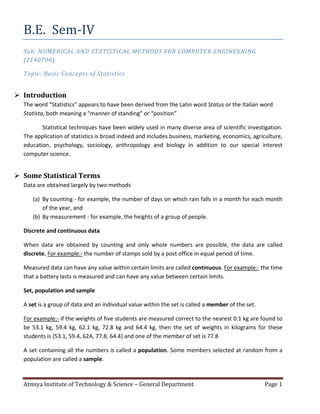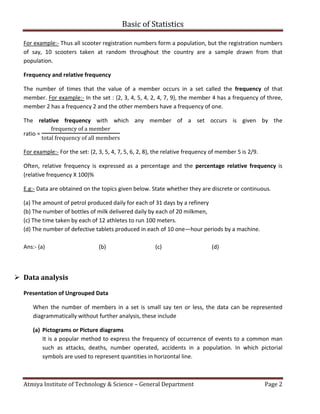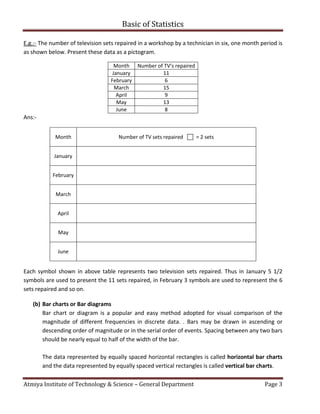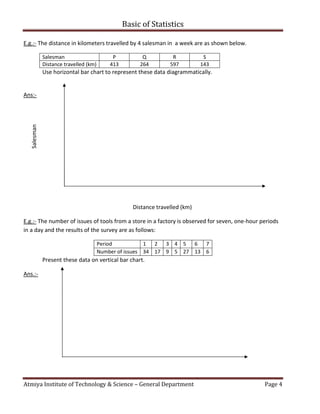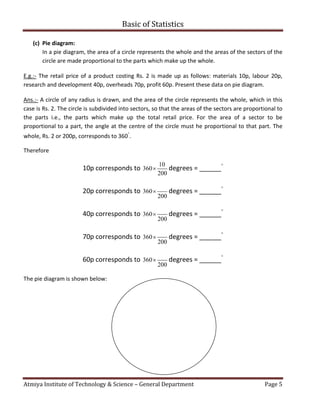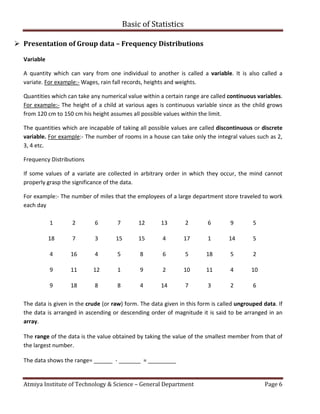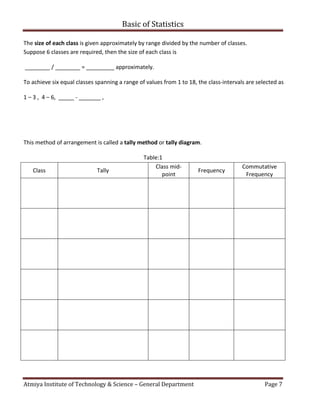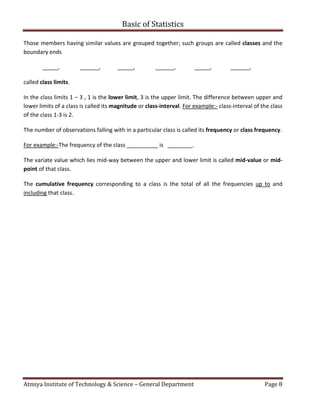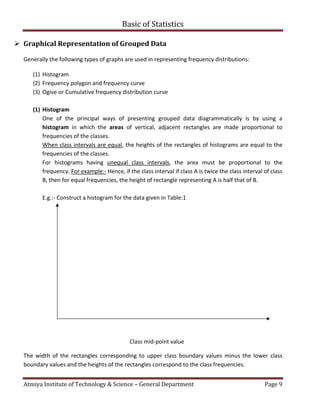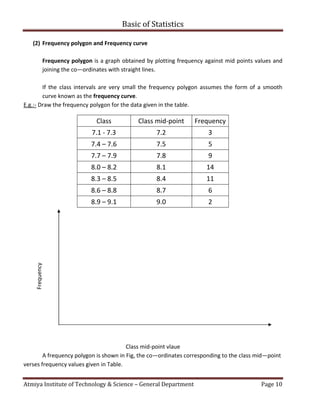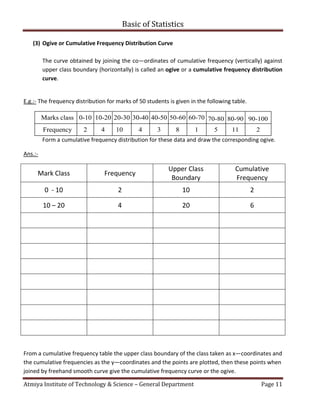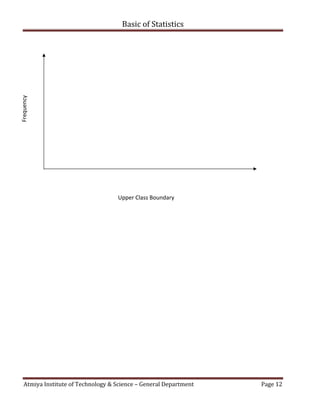Basic Concepts of Statistics - Lecture Notes
- 1. Atmiya Institute of Technology & Science – General Department Page 1 B.E. Sem-IV Sub: NUMERICAL AND STATISTICAL METHODS FOR COMPUTER ENGINEERING (2140706) Topic: Basic Concepts of Statistics Introduction The word “Statistics” appears to have been derived from the Latin word Status or the Italian word Statista, both meaning a “manner of standing” or “position” Statistical techniques have been widely used in many diverse area of scientific investigation. The application of statistics is broad indeed and includes business, marketing, economics, agriculture, education, psychology, sociology, anthropology and biology in addition to our special interest computer science. Some Statistical Terms Data are obtained largely by two methods (a) By counting - for example, the number of days on which rain falls in a month for each month of the year, and (b) By measurement - for example, the heights of a group of people. Discrete and continuous data When data are obtained by counting and only whole numbers are possible, the data are called discrete. For example:- the number of stamps sold by a post office in equal period of time. Measured data can have any value within certain limits are called continuous. For example:- the time that a battery lasts is measured and can have any value between certain limits. Set, population and sample A set is a group of data and an individual value within the set is called a member of the set. For example:- if the weights of five students are measured correct to the nearest 0.1 kg are found to be 53.1 kg, 59.4 kg, 62.1 kg, 72.8 kg and 64.4 kg, then the set of weights in kilograms for these students is {53.1, 59.4, 62A, 77.8, 64.4} and one of the member of set is 77.8 A set containing all the numbers is called a population. Some members selected at random from a population are called a sample.
- 2. Basic of Statistics Atmiya Institute of Technology & Science – General Department Page 2 For example:- Thus all scooter registration numbers form a population, but the registration numbers of say, 10 scooters taken at random throughout the country are a sample drawn from that population. Frequency and relative frequency The number of times that the value of a member occurs in a set called the frequency of that member. For example:- In the set : {2, 3, 4, 5, 4, 2, 4, 7, 9}, the member 4 has a frequency of three, member 2 has a frequency 2 and the other members have a frequency of one. The relative frequency with which any member of a set occurs is given by the ratio = frequency of a member total frequency of all members For example:- For the set: {2, 3, 5, 4, 7, 5, 6, 2, 8}, the relative frequency of member 5 is 2/9. Often, relative frequency is expressed as a percentage and the percentage relative frequency is (relative frequency X 100)% E.g:- Data are obtained on the topics given below. State whether they are discrete or continuous. (a) The amount of petrol produced daily for each of 31 days by a refinery (b) The number of bottles of milk delivered daily by each of 20 milkmen, (c) The time taken by each of 12 athletes to run 100 meters. (d) The number of defective tablets produced in each of 10 one—hour periods by a machine. Ans:- (a) (b) (c) (d) Data analysis Presentation of Ungrouped Data When the number of members in a set is small say ten or less, the data can be represented diagrammatically without further analysis, these include (a) Pictograms or Picture diagrams It is a popular method to express the frequency of occurrence of events to a common man such as attacks, deaths, number operated, accidents in a population. In which pictorial symbols are used to represent quantities in horizontal line.
- 3. Basic of Statistics Atmiya Institute of Technology & Science – General Department Page 3 E.g.:- The number of television sets repaired in a workshop by a technician in six, one month period is as shown below. Present these data as a pictogram. Month Number of TV’s repaired January 11 February 6 March 15 April 9 May 13 June 8 Ans:- Month Number of TV sets repaired = 2 sets January February March April May June Each symbol shown in above table represents two television sets repaired. Thus in January 5 1/2 symbols are used to present the 11 sets repaired, in February 3 symbols are used to represent the 6 sets repaired and so on. (b) Bar charts or Bar diagrams Bar chart or diagram is a popular and easy method adopted for visual comparison of the magnitude of different frequencies in discrete data. . Bars may be drawn in ascending or descending order of magnitude or in the serial order of events. Spacing between any two bars should be nearly equal to half of the width of the bar. The data represented by equally spaced horizontal rectangles is called horizontal bar charts and the data represented by equally spaced vertical rectangles is called vertical bar charts.
- 4. Basic of Statistics Atmiya Institute of Technology & Science – General Department Page 4 E.g.:- The distance in kilometers travelled by 4 salesman in a week are as shown below. Salesman P Q R S Distance travelled (km) 413 264 597 143 Use horizontal bar chart to represent these data diagrammatically. Ans:- Distance travelled (km) E.g.:- The number of issues of tools from a store in a factory is observed for seven, one-hour periods in a day and the results of the survey are as follows: Period 1 2 3 4 5 6 7 Number of issues 34 17 9 5 27 13 6 Present these data on vertical bar chart. Ans.:- Salesman
- 5. Basic of Statistics Atmiya Institute of Technology & Science – General Department Page 5 (c) Pie diagram: In a pie diagram, the area of a circle represents the whole and the areas of the sectors of the circle are made proportional to the parts which make up the whole. E.g.:- The retail price of a product costing Rs. 2 is made up as follows: materials 10p, labour 20p, research and development 40p, overheads 70p, profit 60p. Present these data on pie diagram. Ans.:- A circle of any radius is drawn, and the area of the circle represents the whole, which in this case is Rs. 2. The circle is subdivided into sectors, so that the areas of the sectors are proportional to the parts i.e., the parts which make up the total retail price. For the area of a sector to be proportional to a part, the angle at the centre of the circle must he proportional to that part. The whole, Rs. 2 or 200p, corresponds to 360 ◦ . Therefore 10p corresponds to 10 360 200 degrees = ______ ◦ 20p corresponds to 360 200 degrees = ______ ◦ 40p corresponds to 360 200 degrees = ______ ◦ 70p corresponds to 360 200 degrees = ______ ◦ 60p corresponds to 360 200 degrees = ______ ◦ The pie diagram is shown below:
- 6. Basic of Statistics Atmiya Institute of Technology & Science – General Department Page 6 Presentation of Group data – Frequency Distributions Variable A quantity which can vary from one individual to another is called a variable. It is also called a variate. For example:- Wages, rain fall records, heights and weights. Quantities which can take any numerical value within a certain range are called continuous variables. For example:- The height of a child at various ages is continuous variable since as the child grows from 120 cm to 150 cm his height assumes all possible values within the limit. The quantities which are incapable of taking all possible values are called discontinuous or discrete variable. For example:- The number of rooms in a house can take only the integral values such as 2, 3, 4 etc. Frequency Distributions If some values of a variate are collected in arbitrary order in which they occur, the mind cannot properly grasp the significance of the data. For example:- The number of miles that the employees of a large department store traveled to work each day 1 2 6 7 12 13 2 6 9 5 18 7 3 15 15 4 17 1 14 5 4 16 4 5 8 6 5 18 5 2 9 11 12 1 9 2 10 11 4 10 9 18 8 8 4 14 7 3 2 6 The data is given in the crude (or raw) form. The data given in this form is called ungrouped data. If the data is arranged in ascending or descending order of magnitude it is said to be arranged in an array. The range of the data is the value obtained by taking the value of the smallest member from that of the largest number. The data shows the range= ______ - _______ = _________
- 7. Basic of Statistics Atmiya Institute of Technology & Science – General Department Page 7 The size of each class is given approximately by range divided by the number of classes. Suppose 6 classes are required, then the size of each class is ________ / ________ = _________ approximately. To achieve six equal classes spanning a range of values from 1 to 18, the class-intervals are selected as 1 – 3 , 4 – 6, _____ - _______ , This method of arrangement is called a tally method or tally diagram. Table:1 Class Tally Class mid- point Frequency Commutative Frequency
- 8. Basic of Statistics Atmiya Institute of Technology & Science – General Department Page 8 Those members having similar values are grouped together; such groups are called classes and the boundary ends _____, ______, _____, ______, _____, ______, called class limits. In the class limits 1 – 3 , 1 is the lower limit, 3 is the upper limit. The difference between upper and lower limits of a class is called its magnitude or class-interval. For example:- class-interval of the class of the class 1-3 is 2. The number of observations falling with in a particular class is called its frequency or class frequency. For example:-The frequency of the class __________ is ________. The variate value which lies mid-way between the upper and lower limit is called mid-value or mid- point of that class. The cumulative frequency corresponding to a class is the total of all the frequencies up to and including that class.
- 9. Basic of Statistics Atmiya Institute of Technology & Science – General Department Page 9 Graphical Representation of Grouped Data Generally the following types of graphs are used in representing frequency distributions: (1) Histogram (2) Frequency polygon and frequency curve (3) Ogive or Cumulative frequency distribution curve (1) Histogram One of the principal ways of presenting grouped data diagrammatically is by using a histogram in which the areas of vertical, adjacent rectangles are made proportional to frequencies of the classes. When class intervals are equal, the heights of the rectangles of histograms are equal to the frequencies of the classes. For histograms having unequal class intervals, the area must be proportional to the frequency. For example:- Hence, if the class interval if class A is twice the class interval of class B, then for equal frequencies, the height of rectangle representing A is half that of B. E.g.:- Construct a histogram for the data given in Table:1 Class mid-point value The width of the rectangles corresponding to upper class boundary values minus the lower class boundary values and the heights of the rectangles correspond to the class frequencies.
- 10. Basic of Statistics Atmiya Institute of Technology & Science – General Department Page 10 (2) Frequency polygon and Frequency curve Frequency polygon is a graph obtained by plotting frequency against mid points values and joining the co—ordinates with straight lines. If the class intervals are very small the frequency polygon assumes the form of a smooth curve known as the frequency curve. E.g.:- Draw the frequency polygon for the data given in the table. Class Class mid-point Frequency 7.1 - 7.3 7.2 3 7.4 – 7.6 7.5 5 7.7 – 7.9 7.8 9 8.0 – 8.2 8.1 14 8.3 – 8.5 8.4 11 8.6 – 8.8 8.7 6 8.9 – 9.1 9.0 2 Class mid-point vlaue A frequency polygon is shown in Fig, the co—ordinates corresponding to the class mid—point verses frequency values given in Table. Frequency
- 11. Basic of Statistics Atmiya Institute of Technology & Science – General Department Page 11 (3) Ogive or Cumulative Frequency Distribution Curve The curve obtained by joining the co—ordinates of cumulative frequency (vertically) against upper class boundary (horizontally) is called an ogive or a cumulative frequency distribution curve. E.g.:- The frequency distribution for marks of 50 students is given in the following table. Marks class 0-10 10-20 20-30 30-40 40-50 50-60 60-70 70-80 80-90 90-100 Frequency 2 4 10 4 3 8 1 5 11 2 Form a cumulative frequency distribution for these data and draw the corresponding ogive. Ans.:- Mark Class Frequency Upper Class Boundary Cumulative Frequency 0 - 10 2 10 2 10 – 20 4 20 6 From a cumulative frequency table the upper class boundary of the class taken as x—coordinates and the cumulative frequencies as the y—coordinates and the points are plotted, then these points when joined by freehand smooth curve give the cumulative frequency curve or the ogive.
- 12. Basic of Statistics Atmiya Institute of Technology & Science – General Department Page 12 Upper Class Boundary Frequency

